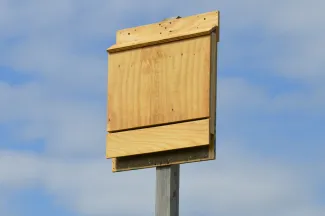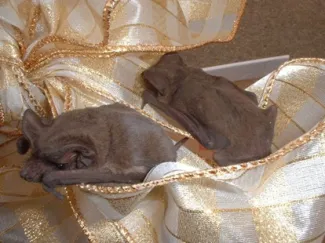More and more, along with managing and improving landscapes for Oklahoma’s game species, landowners are also considering and even targeting habitat improvements and provisions for our nongame species: leaving logs for salamanders and snakes, planting highly diverse native forb mixes for pollinators, or leaving and creating snags (dead, standing trees) for cavity nesters. Strategically managing and manipulating the available native habitat is usually the best approach. However, where natural habitat is not available or cannot be managed for one reason or another, or simply in an effort to maximize availability, landowners may opt to provide artificial habitat.
Duck boxes, artificial turkey roosts, bluebird houses, and underwater habitat structures are all prime examples of these, often species-specific, artificial structures, each of which accommodate essential habitat aspects for their respective targeted wildlife species. Along these lines, bat houses are another such structure that provide available roosts where there are none and encourage bats to use and frequent an area. But before you start erecting bat houses here and there, it’s important to first determine if they are appropriate for your place.

Are There Bats Around?
More than 20 unique and fascinating species of bats are found across Oklahoma. Some have state-wide distribution while others have been documented in only one county. They can be seen in urban, suburban, and rural areas and will mostly inhabit areas that are near a natural water body. Depending on the species, natural roost sites include caves, rock crevices, buildings, trees, canyon walls and cliffs, or even behind the loose bark of trees.
Generally, bats that roost in buildings and trees will also use bat houses, and seven species within the state are known to occupy bat houses during portions of the year. When we consider the collective distribution of species that will use bat houses (Mexican free-tailed bat, big brown bat, little brown bat, cave myotis, evening bat, pallid bat, and little brown myotis), no matter where your property is located across the state, chances are that these artificial roosts will benefit and attract one or a few different species. To find out which bat species could be found near your property, refer to the “Bats of Oklahoma Field Guide”
Should I Install a Bat House?
Properties with ample natural roosts for the bat species found in a given area may not require bat houses in order to really tip the scale of providing available habitat. Especially on suburban and rural properties, landowners can take a larger-scale land management approach by implementing practices like hack and spray, girdling, or prescribed fire to create snags, therefore creating hollow trunks and peeling bark where the bats that will use these spots can avoid predators and enjoy stable temperatures.
Although maybe a bit less welcome, for those that will use buildings for daytime roosting, secluded barn rafters and accessible home attics provide similar security and climate control. In such cases, bat houses may be installed at appropriate, nearby locations to encourage ‘resident’ bats to move from an undesirable roost and into the bat house. From rural to urban settings and aside from strictly providing habitat that is otherwise unavailable, many people install bat houses with the objective of controlling insects like mosquitoes and garden or cropland pests.

Bats that inhabit attics and buildings may be lured away from such roosts by adding bat houses within nearby suitable habitat.
Where Should I Place a Bat House?
Bat houses should be situated in open areas, near the cover of trees while also free of flight-restrictive obstacles. Locations near a natural water source like a river or pond or an artificial water source like a fishpond or bird bath, and close to an area that attracts insects like a flowerbed, garden, or crop field are the perfect place to put a bat house. Avoid dense forests, under electrical lines, and near hazardous and busy roadways. Bat houses that are placed 10-20 feet from the ground are usually best.
Oklahoma’s bats and so many other of our nongame species greatly benefit from direct or indirect management efforts. Aiming our approach of wildlife management to also advantage these animals that fly under the radar is the key to thorough, wide-scale wildlife habitat considerations.